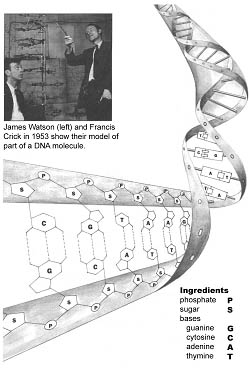
In 1953, James Watson and Francis Crick unraveled the mystery, by showing that DNA had the double-helix structure shown to the left. The information is stored as the sequence of bases: G, C, A, and T, on the strand of DNA running up one side of the double helix. On the opposing strand, the sequence is mirrored such that a C is paired with every G, and an A is paired with every T. This pairing is essential to the ability of DNA to replicate and to send its information out into the cell to direct protein synthesis.
You will be provided with stock solutions of all four bases. These are labeled dAMP for A, dCMP for C, dGMP for G, and dTMP for T to reflect the fact that these bases are only soluble as single bases in their d-MonoPhosphate form. Each of these solutions has a concentration of 0.10M. In the following, feel free to combine these solutions in any way you see fit. Note that the "Solution Info" window shows the concentrations of all chemical species in the currently-selected container. In this window, AT indicates A and T bound together, AC indicates A and C bound together, etc.
1. (2pts) The chemical equation corresponding to binding of the A and C base pairs is
A + C <==> AC
The equilibrium constant for this reaction is referred to as the "binding constant for A and C", and Delta Go for the reaction is the "free energy of binding". Determine the free energy of binding for AT, CG and one mis-match (AC, AG, TC, or TG). Do your results make sense in terms of the structure of DNA? Also, please briefly describe, in a few sentences, how you did the problem (you are not graded on your procedure, but must tell us something).
2. (2pts) The chemical stockroom also contains a solution labeled unknown. This solution contains a 0.10M solution of a "synthetic base". Synthetic bases are designed and used by biologists to manipulate DNA. Which base, A, C, T or G, is this unknown synthetic base most like, in terms of its binding characteristics? Please briefly describe, in a few sentences, how you did the problem (you are not graded on your procedure, but must tell us something).
3. (2pts) What is the equilibrium constant for the following reaction:
A + CT <==> AT + C
Also, please briefly describe, in a few sentences, how you did the problem (you are not graded on your procedure, but must tell us something).